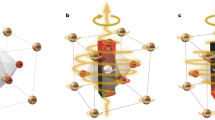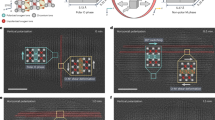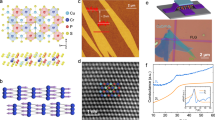Abstract
Correlating electromechanical and dielectric properties with nanometre-scale order is the defining challenge for the development of piezoelectric oxides. Current lead (Pb)-based relaxor ferroelectrics can serve as model systems with which to unravel these correlations, but the nature of the local order and its relation to material properties remains controversial. Here we employ recent advances in diffuse scattering instrumentation to investigate crystals that span the phase diagram of PbMg1/3Nb2/3O3-xPbTiO3 (PMN-xPT) and identify four forms of local order. From the compositional dependence, we resolve the coupling of each form to the dielectric and electromechanical properties observed. We show that relaxor behaviour does not correlate simply with ferroic diffuse scattering; instead, it results from a competition between local antiferroelectric correlations, seeded by chemical short-range order, and local ferroic order. The ferroic diffuse scattering is strongest where piezoelectricity is maximal and displays previously unrecognized modulations caused by anion displacements. Our observations provide new guidelines for evaluating displacive models and hence the piezoelectric properties of environmentally friendly next-generation materials.
This is a preview of subscription content, access via your institution
Access options
Access Nature and 54 other Nature Portfolio journals
Get Nature+, our best-value online-access subscription
$29.99 / 30 days
cancel any time
Subscribe to this journal
Receive 12 print issues and online access
$259.00 per year
only $21.58 per issue
Buy this article
- Purchase on Springer Link
- Instant access to full article PDF
Prices may be subject to local taxes which are calculated during checkout





Similar content being viewed by others
References
Burns, G. & Dacol, F. H. Glassy polarization behavior in ferroelectric compounds Pb(Mg1/3Nb2/3)O3 and Pb(Zn1/3Nb2/3)O3. Solid State Commun. 48, 853–856 (1983).
Xu, G. Probing local polar structures in PZN-xPT and PMN-xPT relaxor ferroelectrics with neutron and x-ray scattering. J. Phys. Conf. Ser. 320, 012081 (2011).
Gehring, P. M. Neutron diffuse scattering in lead-based relaxor ferroelectrics and its relationship to the ultra-high piezoelectricity. J. Adv. Dielectr. 2, 1241005 (2012).
Westphal, V., Kleeman, W. & Glinchuk, M. D. Diffuse phase transitions and random-field-induced domain states of the ‘relaxor’ ferroelectric PbMg1/3Nb2/3O3. Phys. Rev. Lett. 68, 847–850 (1992).
Cowley, R. A., Gvasaliya, S. N., Lushnikov, S. G., Roessli, B. & Rotaru, G. M. Relaxing with relaxors: a review of relaxor ferroelectrics. Adv. Phys. 60, 229–327 (2011).
Fu, D. et al. Relaxor Pb(Mg1/3Nb2/3)O3: a ferroelectric with multiple inhomogeneities. Phys. Rev. Lett. 103, 207601 (2009).
Ni, Y., Chen, H. T., Shi, Y. P., He, L. H. & Soh, A. K. Modeling of polar nanoregions dynamics on the dielectric response of relaxors. J. Appl. Phys. 113, 224104 (2013).
Li, F. et al. The origin of ultrahigh piezoelectricity in relaxor-ferroelectric solid solution crystals. Nat. Commun. 7, 13807 (2016).
Li, F., Xu, Z. & Zhang, S. The effect of polar nanoregions on electromechanical properties of relaxor-PbTiO3 crystals: extracting from electric-field-induced polarization and strain behaviors. Appl. Phys. Lett. 105, 122904 (2014).
Pirc, R., Blinc, R. & Vikhnin, V. S. Effect of polar nanoregions on giant electrostriction and piezoelectricity in relaxor ferroelectrics. Phys. Rev. B 69, 212105 (2004).
Takenaka, H., Grinberg, I., Liu, S. & Rappe, A. M. Slush-like polar structures in single-crystal relaxors. Nature 546, 391–395 (2017).
Hlinka, J. Do we need the ether of polar nanoregions? J. Adv. Dielectr. 2, 1241006 (2012).
Burton, B. P., Cockayne, E. & Waghmare, U. V. Correlations between nanoscale chemical and polar order in relaxor ferroelectrics and the lengthscale for polar nanoregions. Phys. Rev. B 72, 064113 (2005).
Sherrington, D. BZT: a soft pseudospin glass. Phys. Rev. Lett. 111, 227601 (2013).
Akbarzadeh, A. R., Prosandeev, S., Walter, E. J., Al-Barakaty, A. & Bellaiche, L. Finite-temperature properties of Ba(Zr,Ti)O3 relaxors from first principles. Phys. Rev. Lett. 108, 257601 (2012).
Phelan, D. et al. Phase diagram of the relaxor ferroelectric (1−x)Pb(Mg1/3Nb2/3)O3-xPbTiO3 revisited: a neutron powder diffraction study of the relaxor skin effect. Phase Transit. 88, 283–305 (2015).
Bonneau, P. et al. X-ray and neutron diffraction studies of the diffuse phase transition in ceramics. J. Solid State Chem. 91, 350–361 (1991).
de Mathan, N. et al. A structural model for the relaxor PbMg1/3Nb2/3O3 at 5 K. J. Phys. Condens. Matter 3, 8159–8171 (1991).
Guo, Y. et al. The phase transition sequence and the location of the morphotropic phase boundary region in (1− x)[Pb(Mg1/3Nb2/3)O3]–xPbTiO3 single crystal. J. Phys. Condens. Matter 15, L77 (2003).
Bokov, A. A. & Ye, Z. G. Recent progress in relaxor ferroelectrics with perovskite structure. J. Mater. Sci. 41, 31–52 (2006).
Grinberg, I., Juhás, P., Davies, P. & Rappe, A. Relationship between local structure and relaxor behavior in perovskite oxides. Phys. Rev. Lett. 99, 267603 (2007).
Kutnjak, Z., Petzelt, J. & Blinc, R. The giant electromechanical response in ferroelectric relaxors as a critical phenomenon. Nature 441, 956–959 (2006).
Goossens, D. J. Diffuse scattering from lead-containing ferroelectric perovskite oxides. ISRN Mater. Sci. 2013, 107178 (2013).
Goossens, D. J. Local ordering in lead-based relaxor ferroelectrics. Acc. Chem. Res. 46, 2597–2606 (2013).
Xu, G., Zhong, Z., Hiraka, H. & Shirane, G. Three-dimensional mapping of diffuse scattering in Pb(Zn1/3Nb2/3)O3-xPbTiO3. Phys. Rev. B 70, 174109 (2004).
Xu, G., Shirane, G., Copley, J. R. D. & Gehring, P. M. Neutron elastic diffuse scattering study of Pb(Mg1/3Nb2/3)O3. Phys. Rev. B 69, 064112 (2004).
Hiraka, H., Lee, S.-H., Gehring, P. M., Xu, G. & Shirane, G. Cold neutron study on the diffuse scattering and phonon excitations in the relaxor Pb(Mg1/3Nb2/3)O3. Phys. Rev. B 70, 184105 (2004).
Gehring, P. M. et al. Reassessment of the Burns temperature and its relationship to the diffuse scattering, lattice dynamics, and thermal expansion in relaxor Pb(Mg1/3Nb2/3)O3. Phys. Rev. B 79, 224109 (2009).
Stock, C. et al. Universal static and dynamic properties of the structural transition in Pb(Zn1/3Nb2/3)O3. Phys. Rev. B 69, 094104 (2004).
Paściak, M., Wołcyrz, M. & Pietraszko, A. Interpretation of the diffuse scattering in Pb-based relaxor ferroelectrics in terms of three-dimensional nanodomains of the <110>-directed relative interdomain atomic shifts. Phys. Rev. B 76, 014117 (2007).
Vakhrushev, S., Ivanov, A. & Kulda, J. Diffuse neutron scattering in relaxor ferroelectric PbMg1/3Nb2/3O3. Phys. Chem. Chem. Phys. 7, 2340 (2005).
Bosak, A., Chernyshov, D., Vakhrushev, S. & Krisch, M. Diffuse scattering in relaxor ferroelectrics: true three-dimensional mapping, experimental artefacts and modelling. Acta Crystallogr. A. 68, 117–123 (2012).
Takenaka, H., Grinberg, I. & Rappe, A. M. Anisotropic local correlations and dynamics in a relaxor ferroelectric. Phys. Rev. Lett. 110, 147602 (2013).
Phelan, D. et al. Role of random electric fields in relaxors. Proc. Natl Acad. Sci. USA 111, 1754 (2014).
Stock, C. et al. Neutron and x-ray diffraction study of cubic [111] field-cooled Pb(Mg1∕3Nb2∕3)O3. Phys. Rev. B 76, 064122 (2007).
Tkachuk, A. & Chen, H. Anti-ferrodistortive nanodomains in PMN relaxor. AIP Conf. Proc. 677, 55 (2003).
Swainson, I. et al. Soft phonon columns on the edge of the Brillouin zone in the relaxor PbMg1/3Nb2/3O3. Phys. Rev. B 79, 224301 (2009).
Hilton, A. D., Barber, D. J., Randall, C. A. & Shrout, T. R. On short range ordering in the perovskite lead magnesium niobate. J. Mater. Sci. 25, 3461–3466 (1990).
Xu, G., Zhong, Z., Bing, Y., Ye, Z.-G. & Shirane, G. Electric-field-induced redistribution of polar nano-regions in a relaxor ferroelectric. Nat. Mater. 5, 134–140 (2006).
Li, Q. et al. Soft phonon modes and diffuse scattering in Pb(In1/2Nb1/2)O3-Pb(Mg1/3Nb2/3)O3-PbTiO3 relaxor. Preprint at https://arxiv.org/abs/1610.09768 (2016).
Pasciak, M. et al. Assessing local structure in PbZn1/3Nb2/3O3 using diffuse scattering and reverse Monte Carlo refinement. Metall. Mater. Trans. A 44, 87–93 (2013).
Welberry, T. R. et al. Single-crystal neutron diffuse scattering and Monte Carlo study of the relaxor ferroelectric PbZn1/3Nb2/3O3 (PZN). J. Appl. Crystallogr. 38, 639–647 (2005).
Stock, C. et al. Damped soft phonons and diffuse scattering in 40%Pb(Mg1/3Nb2/3)O3-60%PbTiO3. Phys. Rev. B 73, 064107 (2006).
Xu, G., Viehland, D., Li, J. F., Gehring, P. M. & Shirane, G. Evidence of decoupled lattice distortion and ferroelectric polarization in the relaxor system PMN-xPT. Phys. Rev. B 68, 212410 (2003).
Gehring, P. M., Chen, W., Ye, Z.-G. & Shirane, G. The non-rhombohedral low-temperature structure of PMN-10% PT. J. Phys. Condens. Matter 16, 7113 (2004).
Matsuura, M. et al. Composition dependence of the diffuse scattering in the relaxor ferroelectric compound (1 − x)Pb(Mg1∕ 3Nb2∕ 3)O3−xPbTiO3 (0 ≤ x ≤ 0.40). Phys. Rev. B 74, 144107 (2006).
Jin, Y. M., Wang, Y. U. & Khachaturyan, A. G. Conformal miniaturization of domains with low domain-wall energy: monoclinic ferroelectric states near the morphotropic phase boundaries. Phys. Rev. Lett. 91, 197601 (2003).
Vakhrushev, S., Nabereznov, A., Sinha, S. K., Feng, Y. P. & Egami, T. Synchrotron X-ray scattering study of lead magnoniobate relaxor ferroelectric crystals. J. Phys. Chem. Solids 57, 1517–1523 (1996).
Prosandeev, S. & Bellaiche, L. Effects of atomic short-range order on properties of the PbMg1/3Nb2/3O3 relaxor ferroelectric. Phys. Rev. B 94, 180102 (2016). (R).
Rosenkranz, S. & Osborn, R. Corelli: efficient single crystal diffraction with elastic discrimination. Pramana J. Phys. 71, 705–711 (2008).
Ye, F., Liu, Y., Whitfield, R., Osborn, R. & Rosenkranz, S. Implementation of cross correlation for energy discrimination on the time-of-flight spectrometer CORELLI. J. Appl. Cryst. 51, 315–322 (2018).
Arnold, O. et al. Mantid-data analysis and visualization package for neutron scattering and μ SR experiments. Nucl. Instrum. Meth. Phys. Res. A 764, 156–166 (2014).
Michels-Clark, T. M., Savici, A. T., Lynch, V. E., Wang, X. & Hoffmann, C. M. Expanding Lorentz and spectrum corrections to large volumes of reciprocal space for single-crystal time-of-flight neutron diffraction. J. Appl. Crystallogr. 49, 497–506 (2016).
Crystal Coordinate Transformation Workflow (CCTW). Advanced Photon Source, Argonne National Laboratory (2017); https://www.aps.anl.gov/Science/Scientific-Software/CCTW.
Singh, A., Pandey, D. & Zaharko, O. Powder neutron diffraction study of phase transitions in and a phase diagram of (1−x)[Pb(Mg1/3Nb2/3)O3]-xPbTiO3. Phys. Rev. B 74, 024101 (2006).
Acknowledgements
Work at the Materials Science Division at Argonne National Laboratory was supported by the US Department of Energy, Office of Science, Materials Sciences and Engineering Division. Research conducted at ORNL’s Spallation Neutron Source was sponsored by the Scientific User Facilities Division, Office of Basic Energy Sciences, US Department of Energy. Research conducted at the Cornell High Energy Synchrotron Source (CHESS) was supported by the NSF and NIH/NIGMS via NSF award DMR-1332208. The work at Simon Fraser University was supported by the US Office of Naval Research (ONR grant numbers N00014-12-11045 and N00014-16-1-3106) and the Natural Sciences and Engineering Research Council of Canada (NSERC grant number 203773). We acknowledge the support of the National Institute of Standards and Technology, US Department of Commerce, in providng access to the neutron Prompt Gamma Activation Analysis (PGAA) research facilities used in this work. We also acknowledge the assistance of R. Paul in performing the PGAA measurements and data analysis.
Author information
Authors and Affiliations
Contributions
D.P. directed the project with guidance from P.M.G. M.J.K., P.M.G., S.R., F.Y., Y.L. and D.P. performed the diffuse neutron scattering experiments. M.J.K., S.R., J.P.C.R., R.O. and D.P. performed the X-ray diffuse scattering experiments. J.M.W. and R.O. developed the infrastructure to transform X-ray data into reciprocal space. W. Chen, Z.-G.Y. and H.L. grew single crystals. P.M.G. performed neutron prompt gamma measurements and analysis. M.J.K. performed the diffuse scattering analysis. D.P., M.J.K., P.M.G. and S.R. wrote the manuscript, with contributions from R.O., Z.-G.Y., Y.L., F.Y. and J.P.C.R. O.C. provided guidance to M.J.K.
Corresponding author
Ethics declarations
Competing Interests
The authors declare no competing interests.
Additional information
Publisher’s note: Springer Nature remains neutral with regard to jurisdictional claims in published maps and institutional affiliations.
Supplementary information
Supplementary Information
Supplementary Notes 1–5, Supplementary References 1,2, Supplementary Figures 1–6
Rights and permissions
About this article
Cite this article
Krogstad, M.J., Gehring, P.M., Rosenkranz, S. et al. The relation of local order to material properties in relaxor ferroelectrics. Nature Mater 17, 718–724 (2018). https://doi.org/10.1038/s41563-018-0112-7
Received:
Accepted:
Published:
Issue Date:
DOI: https://doi.org/10.1038/s41563-018-0112-7
This article is cited by
-
Polarization behavior in a compositionally graded relaxor–ferroelectric crystal visualized by angle-resolved polarized Raman mapping
Communications Physics (2023)
-
Piezoelectric response of disordered lead-based relaxor ferroelectrics
Communications Materials (2023)
-
Photocarrier-induced persistent structural polarization in soft-lattice lead halide perovskites
Nature Nanotechnology (2023)
-
Emergence of high piezoelectricity from competing local polar order-disorder in relaxor ferroelectrics
Nature Communications (2023)
-
Revealing the role of the constant phase element in relaxor ferroelectrics
Communications Physics (2022)



